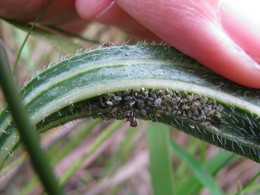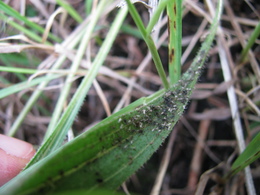It was a dark and stormy morning. With the exception of Jill, Maria, and I, the members of team Echinacea bided their time at the old town hall waiting for the rain to diminish. The three of us had indoor tasks to work on–specifically, sorting ants and entering data. After the sky had exhausted itself, a group of us went to a large site at East Elk Lake Road to search for flowering plants for the annual Echinacea demography census. We had searched the site before, but the cloud cover made prime conditions for finding Echinacea among the shrubs and trees. Stuart, Maria, and Andrew went to another large and difficult-to-search site (Aanenson) to take GPS points on plants.
After that, several of us began censusing Riley, a roadside remnant. The site is full of flowering plants, many of which are growing in the road. Because of this, many of the plants have lost their heads due to mowing. The team finished Riley in the afternoon, leaving enough time to census a nearby site we call Woody’s.
I spent the afternoon excluding aphids from plants in my aphid addition/exclusion experiment. Aphid infestation is clearly on the decline for the season. Each time I perform aphid exclusion, I record the number of aphids present on the plant before I remove them. This time yielded the lowest aphid counts in my exclusion group this summer. I haven’t crunched the numbers yet, but based on my exclusion data I estimate that the peak of aphid season was probably between July 25th and August 1st. That is much earlier than last year, when the peak was between August 12th and 26th.
Last Saturday when I was performing aphid additions, I noticed that a lot of the plants in my addition group had colonies of dead aphids. For example, one plant that hosted nearly 2000 aphids on July 21st was down to 7 last Saturday. For an idea of what this transformation looks like, here’s a picture of a dense, thriving aphid colony:
And here’s a picture of a colony that has died off:
It is unclear why this happens so suddenly, considering the plant is still green. My guess is a surge of defensive chemicals in the plant.
On Thursday, all the undergraduates are going to the University of Minnesota for a poster session. They all did a great job on their research projects and put a lot of time and effort into their posters. I wish them all good luck in their presentations and look forward to hearing about their experience.



Leave a Reply